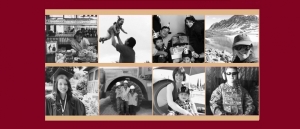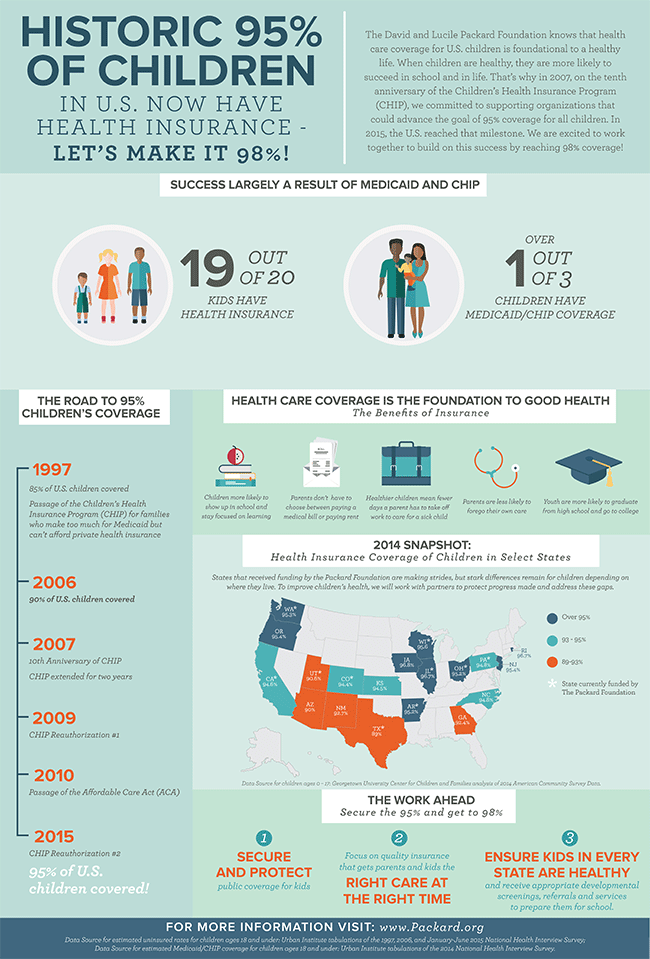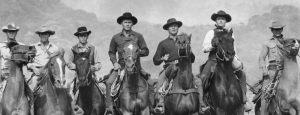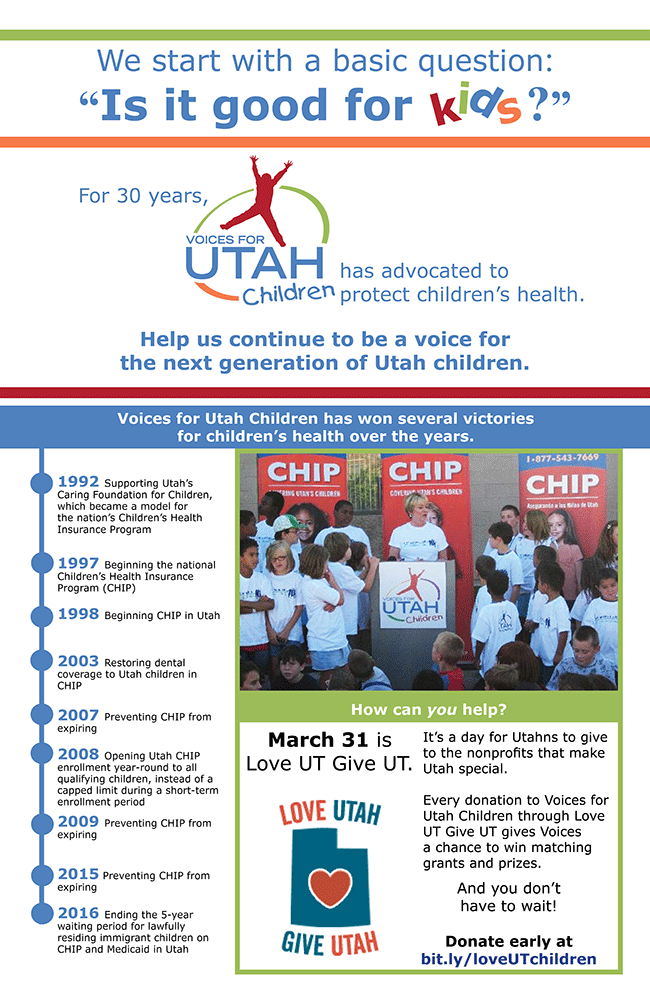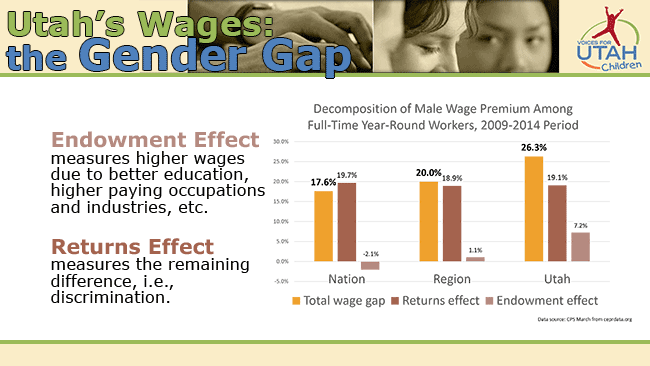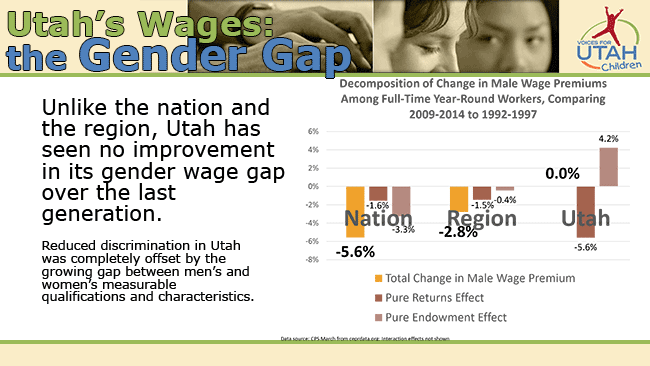State Policy
 The goal of the Working Families Benchmarking Project is to identify a variety of economic trends affecting working families across Utah, and then to examine those issues through a comparative lens, evaluating Utah’s overall progress by using a peer state as a benchmark. Colorado was chosen for this inaugural edition, in part for its geographic proximity to Utah — and thus relatively similar regional identity — as well as for its comparable rates of economic and population growth, demographics, and policy challenges.
The goal of the Working Families Benchmarking Project is to identify a variety of economic trends affecting working families across Utah, and then to examine those issues through a comparative lens, evaluating Utah’s overall progress by using a peer state as a benchmark. Colorado was chosen for this inaugural edition, in part for its geographic proximity to Utah — and thus relatively similar regional identity — as well as for its comparable rates of economic and population growth, demographics, and policy challenges.
Many existing economic comparison studies and rankings look at the economy as a whole or at its impact on specific sectors or on employers. This project seeks to augment those very useful comparisons by focusing on how the economy is experienced by middle and lower-income families. In particular, it is these families whose children are most at risk for not achieving their potential in school and later in the workplace and in society in general. Thus, how they experience the economy is of particular interest to Voices for Utah Children.
In Part I of the Project, we focus on economic opportunity. The dynamism, flexibility, and competitiveness of a state’s economy is a major contributor to economic opportunity, so we look at this topic through a wide range of metrics, from business climate and entrepreneurship rankings to educational attainment and demographic gaps.
Utah ranks ahead of Colorado in:
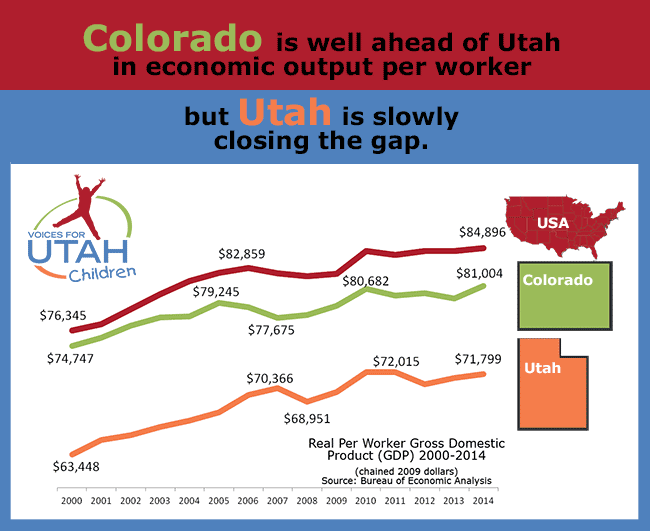 Business climate rankings
Business climate rankings- Gross Domestic Product (GDP) growth
- Lower unemployment
- Labor force participation
- Higher education system investment
- Referring fewer minority youth to the correctional system
- Reducing inequality and increasing social mobility
Colorado outpaces Utah in:
- Pre-K and kindergarten enrollment
- K-12 investment and performance
- Higher education attainment
- Workforce productivity
- Entrepreneurship
- The status of women in the economy
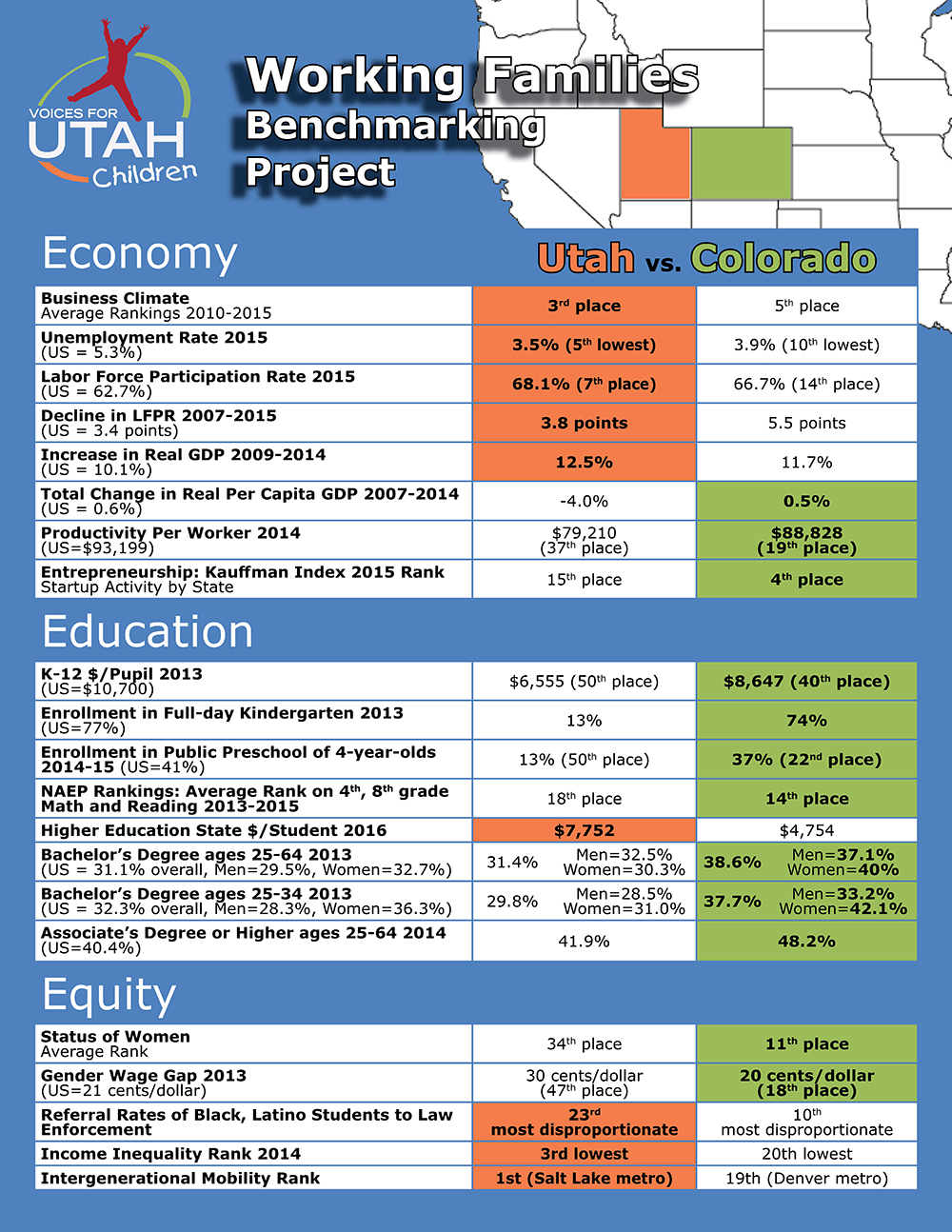
The gaps in educational attainment are perhaps the finding
of greatest concern for Utah’s long-term future.
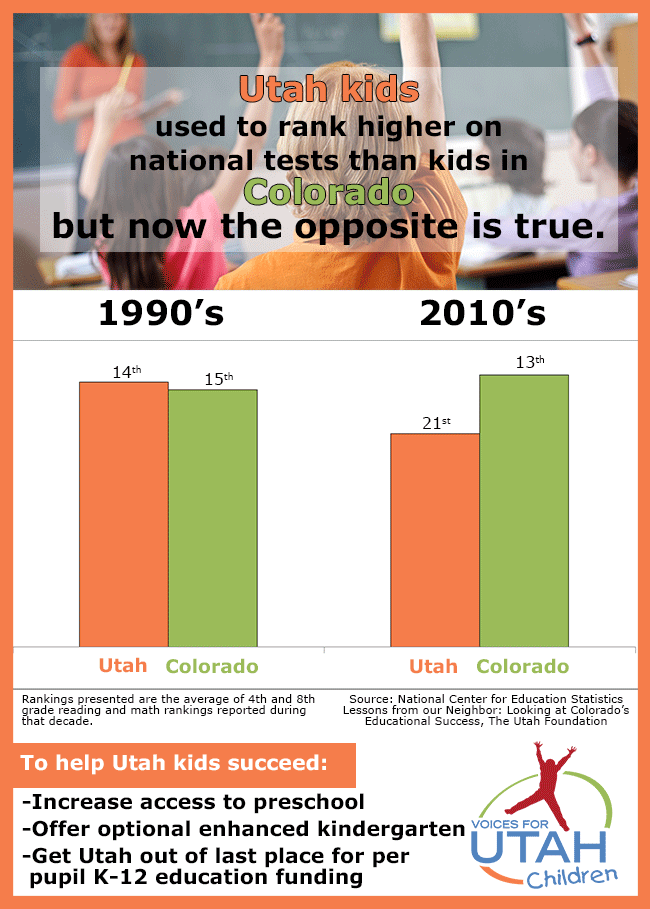
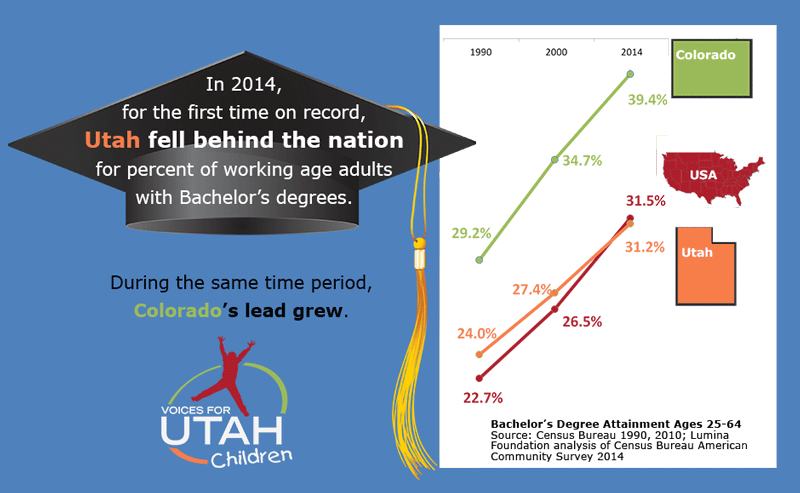
Since education is the foundation of opportunity and prosperity in a modern economy, Colorado’s success in educating its population and attracting highly educated migrants from other states may well hold lessons for Utah. Utah is wise to invest more that Colorado in higher education to attempt to make up this gap and should apply a similar lesson in the area of pre-K-12 funding.
As Utah builds on its many assets and grapples with its challenges in the years to come, we hope that this benchmarking project may contribute in a constructive way to the broader economic policy conversation among experts, policymakers, and the general public.
For more detailed information, see the complete printer-friendly report:
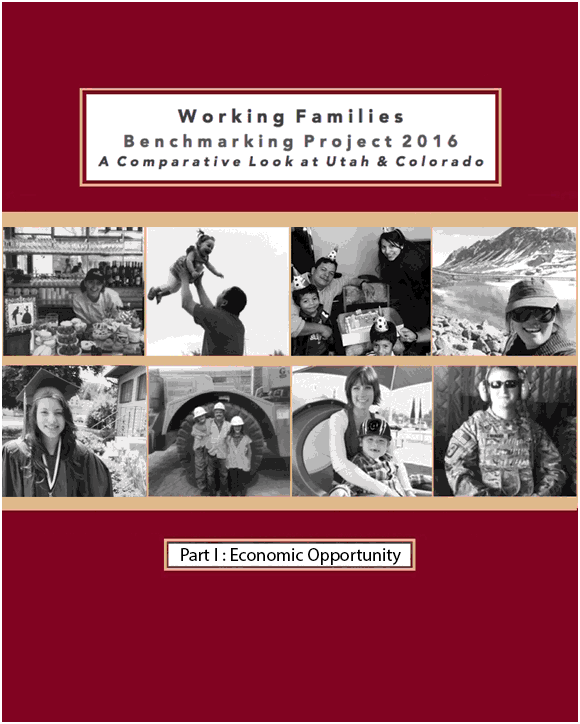
![]() Working Families Benchmarking Project Part One: Economic Opportunity
Working Families Benchmarking Project Part One: Economic Opportunity
These measures of economic opportunity also relate directly to the questions we address in Part 2: Standard of Living.
For 30 years now, Voices for Utah Children has called on our state, federal and local leaders to put children’s needs first. But the work is not done. The children of 30 years ago now have children of their own. Too many of these children are growing up in poverty, without access to healthcare or quality educational opportunities.
How can you be involved?
Make a tax-deductible donation to Voices for Utah Children—or join our Network with a monthly donation of $20 or more. Network membership includes complimentary admission to Network events with food, socializing, and opportunity to meet child advocacy experts. And don't forget to join our listserv to stay informed!
We look forward to the future of Voices for Utah Children and we hope you will be a part of our next 30 years.
Special thanks to American Express for sponsoring our 30th Anniversary Year. 
Mass Incarceration of Parents Hurts Kids
The latest Annie E. Casey Foundation report, A Shared Sentence: the devastating toll of parental incarceration on kids, families and communities, states that “the most powerful step, by far” to protect the children of parents in the justice system “is to reduce our nation’s overreliance on incarceration.” Having an incarcerated parent is a traumatic experience for a child with long-lasting health effects and often leads to poverty, which is also a threat to child well-being.
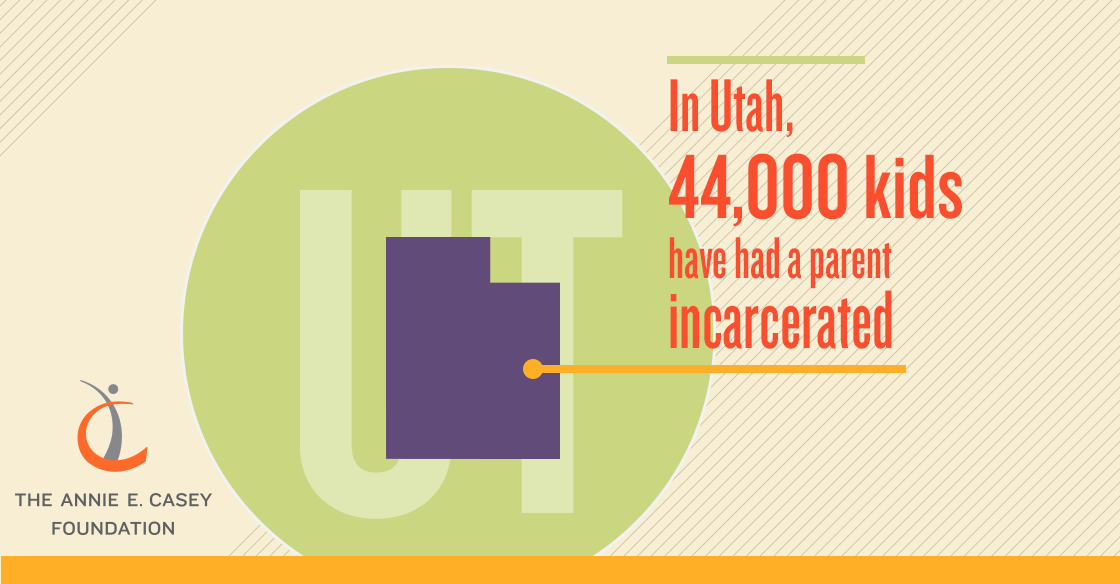 The report demonstrates that during the eighties and nineties, the number of kids with a father in prison or jail rose by 500%. Rising incarceration rates thwarted an opportunity to reduce the U.S. poverty rate by 20%; researchers point to increased incarceration as the factor that kept poverty rates from dropping.
The report demonstrates that during the eighties and nineties, the number of kids with a father in prison or jail rose by 500%. Rising incarceration rates thwarted an opportunity to reduce the U.S. poverty rate by 20%; researchers point to increased incarceration as the factor that kept poverty rates from dropping.
“While momentum for criminal justice reform continues to build, we know progress will take time. But we also know children can’t wait—nor can we as a nation afford to let them and their parents flounder, perpetuating poverty from one generation to the next.”
–Annie E. Casey Foundation
“There is no question that our country’s practice of mass incarceration is flawed, costly and in need of change,” states the report. The report lists several alternatives to overusing prisons and jails:
- Shorter sentences for nonviolent crimes (The majority of incarcerated persons are serving time for nonviolent offenses.)
- Alternative punishments to jail and prison for nonviolent offenders
- Not imprisoning people awaiting trial who can’t afford bail (People imprisoned while waiting for trial can lose their jobs, child care or homes even if they are absolved of wrongdoing.)
Another recent report released by the Sentencing Project, Fewer Prisoners, Less Crime: A Tale of Three States, profiled three states that dramatically reduced their prison populations in recent years and found that “during their period of decarceration, violent crime rates fell at a greater rate in these three states than they did nationwide.” The report concludes, “At least in three states we now know that the prison population can be reduced by about 25% with little or no adverse effect on public safety.”
Perhaps Utah should take a long look at states that are finding success in reducing the prison population. Do we also have an opportunity to improve outcomes for children and their families by reducing our prison population?
For 30 years now, Voices for Utah Children has called on our state, federal and local leaders to put children’s needs first. But the work is not done. The children of 30 years ago now have children of their own. Too many of these children are growing up in poverty, without access to healthcare or quality educational opportunities.
How can you be involved?
Make a tax-deductible donation to Voices for Utah Children—or join our Network with a monthly donation of $20 or more. Network membership includes complimentary admission to Network events with food, socializing, and opportunity to meet child advocacy experts. And don't forget to join our listserv to stay informed!
We look forward to the future of Voices for Utah Children and we hope you will be a part of our next 30 years.
Special thanks to American Express for sponsoring our 30th Anniversary Year. 
U.S.A. reaches goal of 95% health insurance coverage for children but Utah lags behind
In 2007, on the 10th anniversary of the Children’s Health Insurance Program (CHIP), the David and Lucile Packard Foundation and its partners committed to helping ensure that 95% of the nation’s children ages 0 to 18 had health insurance. This year the nation reached this historic goal, according to the Urban Institute’s report: Uninsurance among Children, 1997–2015 : Long-Term Trends and Recent Patterns. The success of CHIP and the expansion of Medicaid in many states were critical for reaching these historic numbers for health insurance coverage.
However, Utah lags the nation, with only 90.6% of Utah children insured. In fact, Utah ranks among the bottom of all states for children’s health insurance coverage and Utah Hispanic children are particularly unlikely to have health insurance. Nationwide, 9.7% of Hispanic children are uninsured but 23.4% of Utah Hispanic children are uninsured.
Children with access to quality, comprehensive health coverage are more likely to attend school and stay focused on learning. Healthier children means parents take fewer days off work to care for a sick child. It also means parents don’t have to choose between paying a medical bill or paying rent.
How can we get more Utah kids covered?
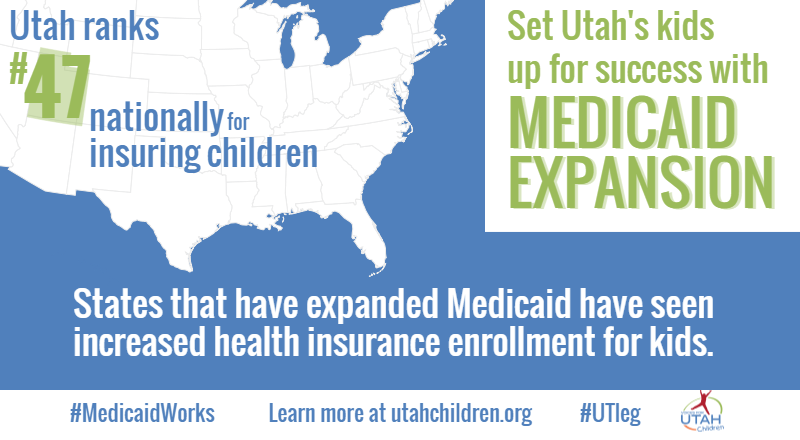 Follow through with the work begun at the 2016 Legislature. During the recent session, Utah lawmakers added intent language to end the 5-year wait for lawfully residing immigrant children, agreed to study options to improve enrollment in Medicaid, and allocated funding to Medicaid and CHIP outreach for the first time in years. Let’s finish what we started.
Follow through with the work begun at the 2016 Legislature. During the recent session, Utah lawmakers added intent language to end the 5-year wait for lawfully residing immigrant children, agreed to study options to improve enrollment in Medicaid, and allocated funding to Medicaid and CHIP outreach for the first time in years. Let’s finish what we started.- Cover the gap. States that fully expanded Medicaid saw more improvement in children’s health insurance coverage than states like Utah. Utah lawmakers chose to leave money on the table in Washington rather than fully cover the gap. Expanding Medicaid would help Utah address Utah’s low enrollment of eligible children in Medicaid and CHIP, as newly eligible adults enroll their whole families.
- Extend CHIP. CHIP funding is scheduled to end in 2017 despite its overwhelming success.
Now that the goal of getting 95% of children insured has been met nationally, the Packard Foundation has announced a new commitment to reach 98% coverage for our nation’s children. By the time the nation meets this new goal, we hope to be able to say that Utah kids are just as likely to be insured as children across the nation. Let’s catch up now.
For 30 years now, Voices for Utah Children has called on our state, federal and local leaders to put children’s needs first. But the work is not done. The children of 30 years ago now have children of their own. Too many of these children are growing up in poverty, without access to healthcare or quality educational opportunities.
How can you be involved?
Make a tax-deductible donation to Voices for Utah Children—or join our Network with a monthly donation of $20 or more. Network membership includes complimentary admission to Network events with food, socializing, and opportunity to meet child advocacy experts. And don't forget to join our listserv to stay informed!
We look forward to the future of Voices for Utah Children and we hope you will be a part of our next 30 years.
Special thanks to American Express for sponsoring our 30th Anniversary Year. 
Last year, we brought you a version of The Good, The Bad and The Ugly for our legislative overview. For this year’s health policy round-up, we’re relying on another classic Western, The Magnificent Seven, to review the seven main children’s health issues of the session. Not all seven topics made it to the end of the session (much like the gunslingers in the movie). But all of them put up a good fight.
1. Enrolling More Children in CHIP and Medicaid
Utah has one of the highest rates of uninsured children in the nation. We need to take the steps to help children and families enroll–and stay enrolled–in health coverage. There are 85,000 uninsured children in Utah. Even more concerning, the majority of uninsured children in the state are already eligible for health insurance coverage like CHIP or Medicaid but not enrolled.
Fortunately, some important steps were taken this session. The legislature allocated state funding to the Department of Health for CHIP and Medicaid outreach so that more families can learn about their coverage options. In addition, the legislature directed the Department of Health to study some of the barriers to children’s enrollment in CHIP and Medicaid and the fixes needed so more children have coverage. Some of the potential fixes include 12-month continuous eligibility for children on Medicaid, which would allow children to maintain coverage for one full year, even if families experience a change in income or family status. Finally, the legislature removed the five-year waiting period for legal immigrant children to receive CHIP and Medicaid. Immigrant children who would otherwise qualify for CHIP and Medicaid no longer have to wait five years to receive health coverage.
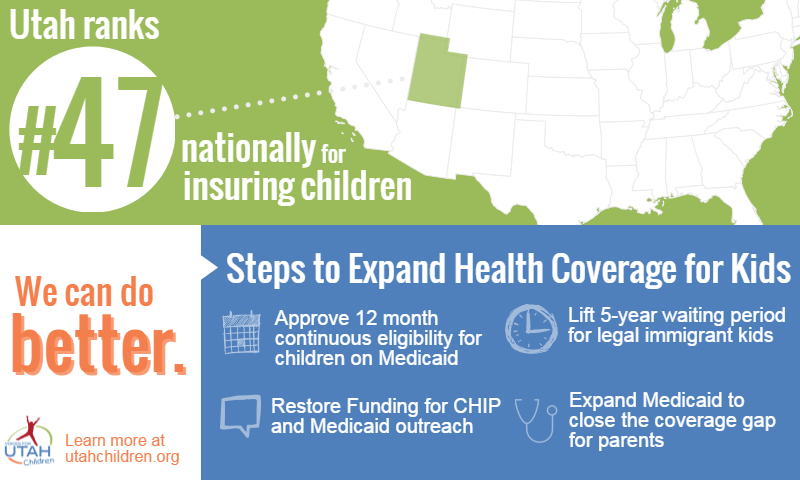
2. Health Coverage for Parents
Healthy parents = healthy children. When parents have insurance, they are better able to care for their children. In addition, when parents have coverage they bring their children along too. Enrollment numbers for children go up when parents have health coverage. Unfortunately there are tens of thousands of uninsured parents in Utah today. While the legislature did not close the coverage gap this session, it took important first steps. HB 437 (Rep Dunnigan R-Taylorsville) changed Medicaid eligibility to cover an estimated 3,800 additional parents, effectively raising the eligibility ceiling for parents with children up to 60% of Federal Poverty Level. More robust bills that did not become law, including SB 77 (Sen Gene Davis D-Salt Lake County), would have expanded Medicaid and closed the coverage gap. In addition, the legislature funded Primary Care Access Grants. These grants help many low-income families and individuals, especially in rural areas. These are important steps to take, but we need to continue on until all Utahns have access to comprehensive health coverage.
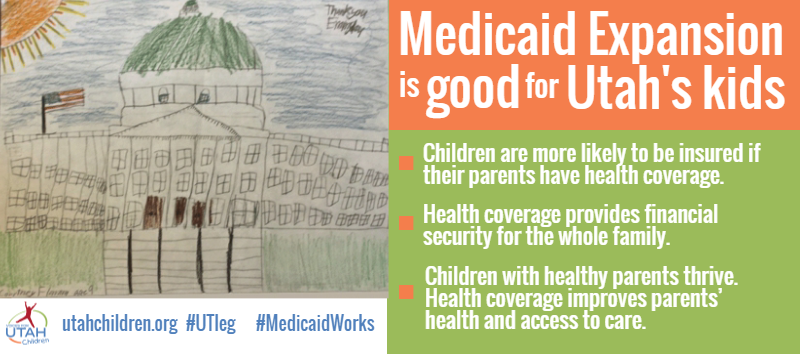
3. Reducing Health Disparities
Children of color are more likely to experience poor health outcomes compared to White children. Utah has the highest rate of uninsured Hispanic children in the nation. Hispanic children make up 17% of the population, but they make up 40% of the total uninsured population. As mentioned above, one win for the session was the elimination of the five-year waiting period for legal immigrant children. Legal permanent resident (LPR) children will soon be able to enroll in CHIP or Medicaid as soon as they qualify, without having to wait five years. At the request of the Governor’s budget, the legislature also allocated funding for Family Spirit, a home visiting program specifically for young Native American families in Utah. The program is a culturally-focused and strength-based approach for new parents and their children. These measures move our state in the right direction; but more work is needed. All children, regardless of their racial or ethnic background, should be able to access the care they need to achieve optimal health.
4. Disease Prevention and Health Promotion
The following public health policies were not enacted, although they would have saved the state money and improved children’s health:
Curtailing Youth Tobacco Use: HB 157 (Representative Kraig Powell R-Heber City) would have raised the age limit for tobacco use and HB 333 (Representative Paul Ray R-Clearfield) imposed an e-cigarette tax. These are important steps to prevent rising rates of e-cigarette use among youth in our state. Despite strong support, including active youth advocacy, both of these bills failed in committee.

Information about Childhood Immunizations: Choosing not to vaccinate your child is a serious decision for one’s child and community. HB 221 (Rep Carol Spackman-Moss D-Salt Lake City) would have required parents who choose not to vaccinate to take a brief online training. The training would inform parents how to recognize the signs and symptoms of disease and learn what to do in the event of a disease outbreak in order to keep their child safe. The bill narrowly passed the House. However in the final days of the session, the Senate made amendments to the bill that undermined its intent. There was not adequate time to resolve these differences and the bill did not pass. As immunization rates in Utah decline, more children are at risk when disease outbreaks occur. This bill highlights the need for continued public health awareness, information and discussion so that all children in Utah can be safe.
Family planning: Representative King sponsored HB 246, Reproductive Health Amendments, that would have provided comprehensive sex education in schools. It also would have allowed more low-income families to receive comprehensive family planning services. This bill would have helped reduce rising rates of sexually transmitted infections by helping more teens make informed choices. However, controversies surrounding sex education kept this bill from advancing out of committee.
5. Services for Children with Special Healthcare Needs
Legislators increased some of the funding for children with special needs. The Baby Watch Early Intervention program received one-time funding to support its critical programs. Legislators including Sen. Luz Escamilla (D-Salt Lake City) and advocates worked tirelessly to make sure the programming could continue. As parents can testify, the Baby Watch Early Intervention program allows parents to receive the early support, assessment and coordination of care they need for their children. The legislature also funded additional slots and increased the caseload for the Medically Complex Children’s Waiver in the Medicaid Program. Additionally, in HB 2, the legislature also allocated funding for the children’s hearing aid pilot program account. In the future, more funds are needed for children with special health care needs, but the legislature took important measures to help more children and families.
6. Crisis Nurseries and Home Visiting for Under-Resourced Families
The Utah legislature allocated funding for families in crisis in HB 2. These funds include TANF funding for domestic violence shelters. It also includes some funding for crisis/respite nurseries under contract with the Division of Child and Family Services. Crisis nurseries play a vital role for families experiencing hardship. In addition, the legislature allocated funding to home visiting programs. The two evidence-based programs funded are Family Spirit and Parents as Teachers. Home visiting programs have been shown to improve the long and short term health outcome for new mothers and their children.
7. Maternal Health and Prenatal Services
The legislature considered several bills that address obstetric care for moms, including two bills that addressed midwifery services. HB 184 (Rep Spackman Moss) made technical changes to current midwifery practices. SB 108 (Sen Deirdre Henderson) removed certain restrictions on licensed birth centers to enable expanded services, despite some concerns from the despite some concerns from physician groups. Both HB 184 and SB 108 passed.
HB 246, Reproductive Health Amendments, also included a provision that would expand family planning services for low-income families that do not qualify for Medicaid. Since this bill failed in committee, it was a missed opportunity for the state to apply for a waiver to extend family planning services for women at 138% of Federal Poverty Level. The state would have received an enhanced federal matching rate for such services, making this a cost-effective policy change for the state. In addition, the provision would have helped individuals who fall in the coverage gap receive comprehensive family planning services.
Those are some of the “magnificent” seven health topics from the 2016 legislative session. For more information on any of the issues or bills mentioned, please contact Jessie Mandle. Voices for Utah Children will continue the fight this coming year so that all children in our state can achieve health and wellness.
 March 31, 2016 is Love UT Give UT!
March 31, 2016 is Love UT Give UT!
It’s a day for Utahns to give to the nonprofits that make Utah special. Every donation to Voices for Utah Children through Love UT Give UT gives Voices a chance to win matching grants and prizes.
And you don't have to wait! Donate now at http://bit.ly/loveUTchildren.
For 30 years now, Voices for Utah Children has called on our state, federal and local leaders to put children’s needs first. But the work is not done. The children of 30 years ago now have children of their own. Too many of these children are growing up in poverty, without access to healthcare or quality educational opportunities.
How can you be involved?
Make a tax-deductible donation to Voices for Utah Children—or join our Network with a monthly donation of $20 or more. Network membership includes complimentary admission to Network events with food, socializing, and opportunity to meet child advocacy experts. And don't forget to join our listserv to stay informed!
We look forward to the future of Voices for Utah Children and we hope you will be a part of our next 30 years.
Special thanks to American Express for sponsoring our 30th Anniversary Year. 
Help us keep protecting children's health with #loveUTgiveUT
 March 31, 2016 is Love UT Give UT!
March 31, 2016 is Love UT Give UT!
It’s a day for Utahns to give to the nonprofits that make Utah special. Every donation to Voices for Utah Children through Love UT Give UT gives Voices a chance to win matching grants and prizes.
And you don't have to wait! Donate now at http://bit.ly/loveUTchildren.
For 30 years now, Voices for Utah Children has called on our state, federal and local leaders to put children’s needs first. But the work is not done. The children of 30 years ago now have children of their own. Too many of these children are growing up in poverty, without access to healthcare or quality educational opportunities.
How can you be involved?
Make a tax-deductible donation to Voices for Utah Children—or join our Network with a monthly donation of $20 or more. Network membership includes complimentary admission to Network events with food, socializing, and opportunity to meet child advocacy experts. And don't forget to join our listserv to stay informed!
We look forward to the future of Voices for Utah Children and we hope you will be a part of our next 30 years.
Special thanks to American Express for sponsoring our 30th Anniversary Year. 
A Tale of Two Utahs: How do Urban and Rural Utah Measure Up?
 It is widely agreed that rural communities have a different set of issues than more urban communities. While all low-income families, regardless of where they live, need connections to support programs and access to economic opportunities, strategies that work in urban areas often cannot be applied to rural areas where social and economic programs are few and far between.
It is widely agreed that rural communities have a different set of issues than more urban communities. While all low-income families, regardless of where they live, need connections to support programs and access to economic opportunities, strategies that work in urban areas often cannot be applied to rural areas where social and economic programs are few and far between.
Because access to services is such an important issue in Utah’s rural areas, it is imperative that policymakers and service providers have a clear view of the problems facing rural communities. In Voices for Utah Children’s annual publication Measures of Child Well-Being in Utah, a variety of child well-being indicators are presented at the county level. These indicators cover important milestones in areas such as economic security, education, and health.
This edition of Data Links explores several of the indicators annually presented in Measures to see how much or if child well-being differs in rural communities as compared to urban communities.
DEFINING URBAN AND RURAL
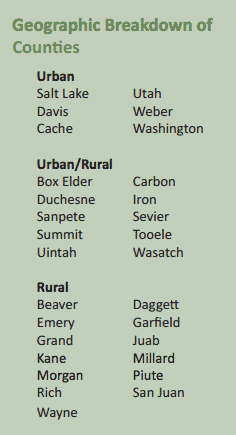 There are a myriad of definitions for “urban” and “rural” from a variety of sources. For the purposes of this report we have chosen to use three categories based on the American Community Survey’s three breakdowns for the one year, three year and five year estimates:
There are a myriad of definitions for “urban” and “rural” from a variety of sources. For the purposes of this report we have chosen to use three categories based on the American Community Survey’s three breakdowns for the one year, three year and five year estimates:
Urban Areas - Areas with populations of 65,000+
Urban/Rural - Areas with populations of 64,999 to 20,000
Rural Areas - Areas of population 20,000 and under
Counties included in each area are indicated in the box to the right.
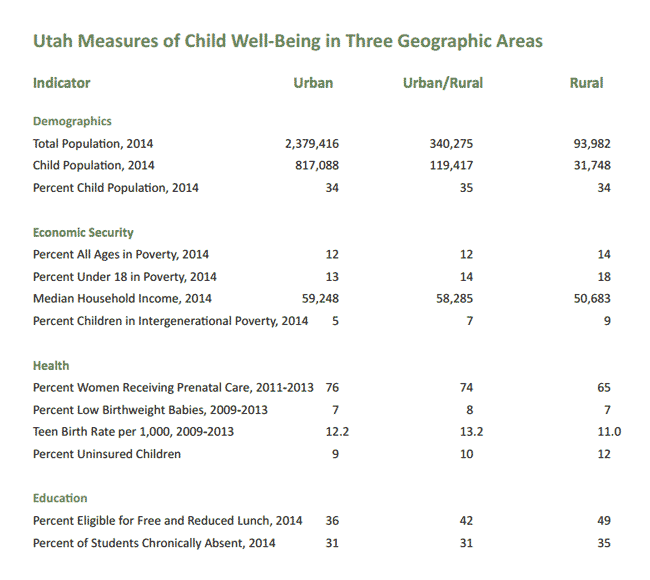

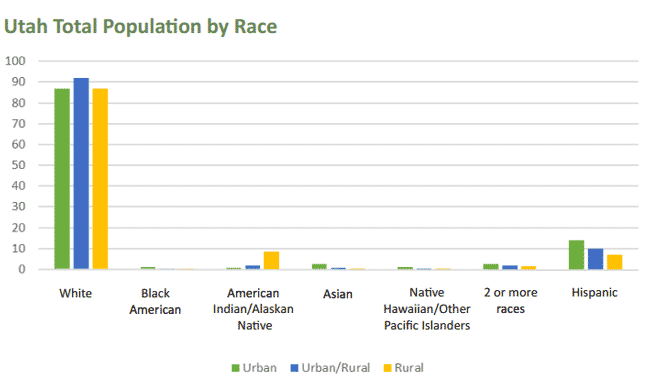
CONCLUSION
This data brief started out by saying it is widely agreed that rural communities have a different set of issues than urban communities. Access to services is difficult for a variety of reasons including lack of transportation and a lack of service providers. When there are no providers in town and individuals must wait on availability, scheduling can become a problem. In some cases where an individual has no family leave policy, traveling to a provider can mean missed wages. Child well-being indicators for children in rural Utah are, in general, slightly worse than those in urban areas. This makes all the above issues even more pressing and an area of concern that needs to be addressed.
“In urban areas, questions of access to care often revolve around whether all segments of the population have access to the full range of specialized medical centers serving the metropolitan area. In rural areas, the issue is often whether there are any health care facilities and providers to access at all. Large metropolitan counties have nearly four times as many physicians per 100,000 residents as do rural counties with only small towns."
Demographic Trends in Rural and Small Town America KENNETH JOHNSON, Carsey Institute Reports on Rural America 01/2006
Printer-friendly report:
![]() A Tale of Two Utahs: How do Urban and Rural Utah Measure Up?
A Tale of Two Utahs: How do Urban and Rural Utah Measure Up?
(Sources and definitions are available in the printer-friendly version of this report.)
 March 31, 2016 is Love UT Give UT!
March 31, 2016 is Love UT Give UT!
It’s a day for Utahns to give to the nonprofits that make Utah special. Every donation to Voices for Utah Children through Love UT Give UT gives Voices a chance to win matching grants and prizes.
And you don't have to wait! Donate now at http://bit.ly/loveUTchildren.
For 30 years now, Voices for Utah Children has called on our state, federal and local leaders to put children’s needs first. But the work is not done. The children of 30 years ago now have children of their own. Too many of these children are growing up in poverty, without access to healthcare or quality educational opportunities.
How can you be involved?
Make a tax-deductible donation to Voices for Utah Children—or join our Network with a monthly donation of $20 or more. Network membership includes complimentary admission to Network events with food, socializing, and opportunity to meet child advocacy experts. And don't forget to join our listserv to stay informed!
We look forward to the future of Voices for Utah Children and we hope you will be a part of our next 30 years.
Special thanks to American Express for sponsoring our 30th Anniversary Year. 
2016 Utah Legislative Session
The 2016 Utah Legislative Session is underway January 25-March 10. Learn more about issues affecting children that will be addressed during this session:
Tax and Budget Issues
Creating a State Earned Income Tax Credit (EITC)
Health Issues
Restore Funds for CHIP and Medicaid Outreach
12-month Continuous Eligibility
Education Issues
Optional Extended Day Kindergarten
Bills
News Contact Lawmakers Sign Up for E-Alerts
For 30 years now, Voices for Utah Children has called on our state, federal and local leaders to put children’s needs first. But the work is not done. The children of 30 years ago now have children of their own. Too many of these children are growing up in poverty, without access to healthcare or quality educational opportunities.
How can you be involved?
Make a tax-deductible donation to Voices for Utah Children—or join our Network with a monthly donation of $20 or more. Network membership includes complimentary admission to Network events with food, socializing, and opportunity to meet child advocacy experts. And don't forget to join our listserv to stay informed!
We look forward to the future of Voices for Utah Children and we hope you will be a part of our next 30 years.
Special thanks to American Express for sponsoring our 30th Anniversary Year. 
Explaining Utah’s Gender Gap in Wages
Utah’s Gender Opportunity
In January 2015, Voices for Utah Children released Utah's Gender Opportunity: An examination of the difference between the earnings of Utah men and women. The report revealed that:
- Nationally, women earn $0.79 for every dollar earned by men. In Utah, the equivalent figure is $0.70.
- Utah has the 4th largest gender gap in the nation.
- Utah’s wage gap has been closing, but at one of the slowest rates in the country.
A new report, Explaining Utah's Gender Gap in Wages, addresses the questions:
- Why does Utah fare so poorly in terms of wage equity?
- What are possible solutions to improve Utah women’s economic status?
Why the Wage Gap Exists
We can think of the wage gap being the result of two factors:
- Women may tend to possess characteristics and qualifications that lead to them being paid less on average (for example, less education than men, an unfavorable occupational distribution, less experience, more family responsibilities, etc.).
- Employers pay women less than men with similar qualifications (discrimination).
First, we quantify how much of the wage gap can be attributed to these two factors:
- How much of the wage gap is due to observed and measurable differences between average attributes – qualifications and characteristics – of men and women (the “endowment effect”)?
- The remainder of the wage gap would be due to variables not measured or controlled for in our regression, including discrimination (the “returns effect”).
Wage Gap Decomposition
Utah has a larger total wage gap than the nation or the Intermountain region, with men earning 26.3% more than women, compared to 20% for the region and 17.6% for the nation. Using the Oaxaca-Blinder decomposition, we break down the total wage gap into the returns and endowment effects.
- In Utah, the endowment effect result shows men earn 7.2% more than women because of men’s measured characteristics relative to women; on average, men are more educated, have higher paying occupations, and work in higher paying industries.
- Utah’s returns effect result shows that the remaining difference (19.1%) is due to men and women being paid differently for the same qualifications and characteristics due to discrimination as well as any other factors that our regression did not account for.
Conclusion: Thus, the returns effect, which is intended to measure discrimination, explains the vast majority of the gender wage gap in Utah, in the Intermountain region, and nationally.
However, as we will see, this is only part of the story.
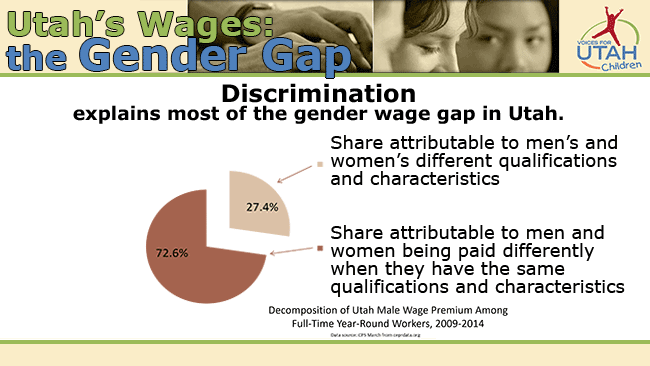
Breaking Down Utah’s Endowment Effect
This chart shows a breakdown of Utah’s endowment effect.
- In Utah, measurable differences between men and women in level of education, occupational choices, and industrial distribution make the wage gap larger.
- At the national and regional levels, industrial composition serves to make the wage gap larger, while education and occupational choice make the wage gap smaller.
In other words, education and occupational choice work in the opposite direction in Utah compared to the national or regional levels.

Why Is Utah Different?
Why does Utah have a larger wage gap than the nation or Utah’s neighbors?
Just as we decomposed the wage gaps, we can also decompose the difference between the wage gaps (Utah vs. its neighbors and Utah vs. the nation) into:
- A part we can attribute exclusively to differences in qualifications and measured attributes (“pure endowment effect”).
- A part we can attribute exclusively to differences in how men and women are paid (“pure returns effect” which is the part that includes discrimination).
- Interaction terms (omitted on the graph because they are small and not interesting on their own).
Decomposition of Wage Gap Differences
- Utah has a larger wage gap than either the nation or Utah’s neighbors.
- Utah has a larger wage gap mainly because of the endowment effect.
- Utah women are more disadvantaged due to education, occupation, and industrial distribution in Utah compared to women at the regional and national levels.
- The differences in the returns effect, which seeks to measure discrimination, do not appear to be statistically significant between Utah and the nation or between Utah and the Intermountain region.
Conclusion: Thus, while the returns effect, which is intended to measure discrimination, explains most of Utah’s gender wage gap, the endowment effect explains most of why Utah’s gap is so much worse than the nation’s.
Differences between men’s and women’s qualifications and characteristics explain over 90% of the difference between Utah’s wage gap and that of the nation.
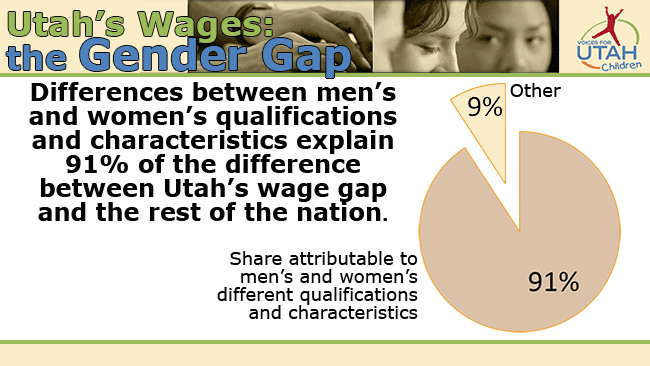
How Utah’s Gap Has Changed Over Time
We would like to know how Utah’s gap now compares to what it was a generation ago (2009-2014 vs. 1992-1997). We can separate the change into:
- A part we can attribute exclusively to changes in men’s and women’s measurable qualifications and characteristics (“pure endowment effect”.
- A part we can attribute exclusively to changes in how men and women are paid when their measurable qualifications and characteristics are equal (“pure returns effect”).
- Interaction terms (omitted on the graph because they are small and not interesting on their own).
Decomposition of Wage Gap Change Over Time
Here, negative numbers indicate an improvement in the wage gap over time.
Unlike the nation and the region, Utah has seen no improvement in its gender wage gap over the last generation.
- Utah has seen significant improvement in the returns effect over the past generation, more so than at the national and regional levels, indicating a diminishment in gender wage discrimination.
- However, that improvement in Utah was completely offset by the growing gap between men’s and women’s measurable qualifications and characteristics.
An Example:
How Men’s and Women’s Measurable Qualifications Have Changed Differently Over the Last Generation
United States vs. Utah, among full-time/year-round working men and women
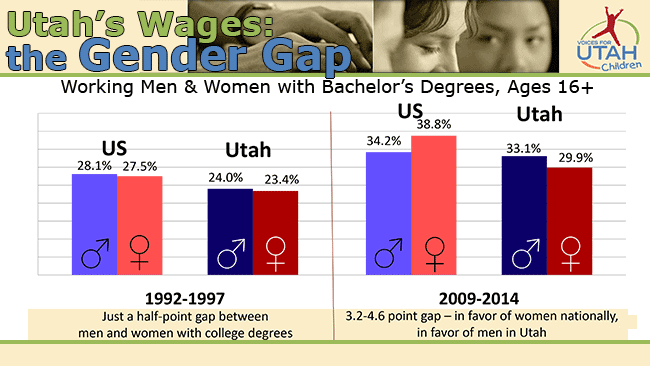
Policy Recommendations
- Pursue policies that seek to end direct wage discrimination.
- Investigate methods to improve women’s educational attainment and occupational and industrial distribution.
- Address workplace and other practices and policies that have a disparate impact on women by making it more difficult to balance work or education with family responsibilities.
- Pursue policies such as the Earned Income Tax Credit (EITC) that increase take-home pay at the lower wage levels, since women make up the majority of lower-wage workers.
Printer-friendly Report:
Explaining Utah's Gender Gap in Wages
The complete thesis which informed this report is available here: Explaining Utah's Gender Gap in Wages, Honors Thesis by Curtis Miller
The January 2015 report quantifying Utah's gender gap is available here: Utah's Gender Opportunity: An examination of the difference between the earnings of Utah men and women
For 30 years now, Voices for Utah Children has called on our state, federal and local leaders to put children’s needs first. But the work is not done. The children of 30 years ago now have children of their own. Too many of these children are growing up in poverty, without access to healthcare or quality educational opportunities.
How can you be involved?
Make a tax-deductible donation to Voices for Utah Children—or join our Network with a monthly donation of $20 or more. Network membership includes complimentary admission to Network events with food, socializing, and opportunity to meet child advocacy experts. And don't forget to join our listserv to stay informed!
We look forward to the future of Voices for Utah Children and we hope you will be a part of our next 30 years.
Special thanks to American Express for sponsoring our 30th Anniversary Year. 

